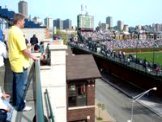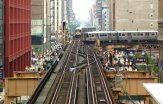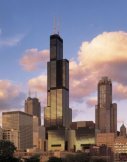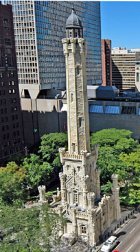
The 1st Wonder is: The Lakefront
 One of the top activities is the "Dog Beach" on the North Side. People are able to let their Retrievers and herders run amok along the shore. One of the top activities is the "Dog Beach" on the North Side. People are able to let their Retrievers and herders run amok along the shore.
Then there's the Navy Pier on the east side downtown with a view of the skyline that takes your breath away. And Shakespeare, and a Ferris wheel!
On the south shore there's the Cultural Center where the water moves to the sounds of Jazz.
Become one of the million people who flock to the 4th of July fireworks.
In the summer, the lake offers respite from the heat and a place of solitude for an early morning run in winter.
The 2nd Wonder is: Wrigley Field
Formerly a working class neighborhood, Wrigleyville, is the neighborhood directly surrounding Wrigley Field along North Clark and West Addison Streets. Wrigleyville features lowrise brick buildings and houses, some with rooftop bleachers colloquially called
Wrigley Roofs. working class neighborhood, Wrigleyville, is the neighborhood directly surrounding Wrigley Field along North Clark and West Addison Streets. Wrigleyville features lowrise brick buildings and houses, some with rooftop bleachers colloquially called
Wrigley Roofs.
Wrigley roofs dot the neighborhood of
Wrigleyville around Wrigley Field, where the
Chicago Cubs play
Major League Baseball. A Wrigley Roof is the name given to the roofs of residential buildings which have bleachers or seating on them to view baseball games or other major events in
Wrigley Field.
People can purchase seats to watch baseball games without having to pay Major League Baseball ticket prices. Proprietors are able to do so under special agreements with the Chicago Cubs organization.


The 3rd Wonder is: The "L"
 The 'L' consists of a network of eight heavy rail lines totalling 106.1 route miles (57.1 miles elevated, 36.9 miles surface, and 12.1 miles subway) on over 242.6 miles of double-track rail line with 144 stations. The oldest section dates from 1892. The 'L' primarily serves the city proper plus eight close-in suburbs. Seventeen stations, mainly newer or at outlying locations, include "park-'n'-ride" facilities with a total of more than 6,600 parking spaces. About 15% of the total track length is underground. The 'L' consists of a network of eight heavy rail lines totalling 106.1 route miles (57.1 miles elevated, 36.9 miles surface, and 12.1 miles subway) on over 242.6 miles of double-track rail line with 144 stations. The oldest section dates from 1892. The 'L' primarily serves the city proper plus eight close-in suburbs. Seventeen stations, mainly newer or at outlying locations, include "park-'n'-ride" facilities with a total of more than 6,600 parking spaces. About 15% of the total track length is underground.
The 'L' is the third busiest rail mass transit system in the United States, behind New York City's and Washington, D.C.'s; and by age is the second oldest rapid transit system in the
Americas after Boston.
It is one of the few rapid transit systems in North America providing 24-hour service, though only on the two busiest lines. On average 658,524 people ride the 'L' each weekday, 419,258 each Saturday, and 315,240 each Sunday. Annual ridership for 2006 was 195.2 million, the highest since 1993.
The 4th Wonder is: Sears Tower
Th e Sears Tower is the tallest building in the
United States, by the measurement from the ground to its roof. e Sears Tower is the tallest building in the
United States, by the measurement from the ground to its roof.
It was also the tallest Skyscraper in the world until 1998, when Petronas Towers in Kuala Lumpur reached 1,483 ft. Then in 2004, the Petronas Towers were surpassed by Taipei 101 in Taipei Taiwan when it reached 1,671 ft.
Commissioned by
Sears, Roebuck and Company, it was designed by chief architect
Bruce Graham and structural engineers Srinivasa "Hal" Iyengar and
Fazlur Khan of
Skidmore, Owings & Merrill.
Construction commenced in August 1970 and the building reached its originally anticipated maximum height on May 3, 1973. When completed, the Sears Tower had overtaken the roof of the
World Trade Center in
New York City as the world's tallest building. The tower has 108 stories as counted by standard methods, though the building owners count the main roof as 109 and the mechanical penthouse roof as 110. There are 101 stories if the mechanical floors (30-32, 64-65, 88-89 & 109-110) are not included. The distance to the roof is 442 m (1,450 ft 7 in), measured from the east entrance.
In February 1982, two television antennas were added to the structure, increasing its total height to 520 m (1,707 ft). The western antenna was later extended to 527 m (1,729 ft) on June 5, 2000 to improve reception of local
NBC station
WMAQ-TV.
Two-story high black bands appear on the tower around the 30th–32nd, 64th–65th, 88th–89th, and 106th–107th floors. These are louvers which allow ventilation for service equipment and obscure the structure's
belt trusses which Sears Roebuck did not want to be visible as on the
John Hancock Center.
The building's official address is 233 South
Wacker Drive, Chicago, Illinois 60606 and on a clear day from the Skydeck at 1,353 feet: 1.5 million visitors can see parts of Illinois, Indiana, Michigan and Wisconsin.

The 5th Wonder is: The Water Tower
 The Chicago Water Tower is a landmark located at 806 North
Michigan Avenue along the
Magnificent Mile shopping district of the city. The Chicago Water Tower is a landmark located at 806 North
Michigan Avenue along the
Magnificent Mile shopping district of the city.
Located adjacent to
Loyola University Chicago's downtown campus, the Chicago Water Tower is listed on the
National Register of Historic Places and serves as the
Chicago Convention and Tourism Bureau Visitor's Welcome Center.
The tower, built in 1869 by architect
William W. Boyington from yellowing
Joliet limestone, is 154 feet tall. Inside was a 138 foot high standpipe to hold water. In addition to being used for
firefighting, the pressure in the pipe could be regulated to control water surges in the area.
The tower gained notoriety after the
Great Chicago Fire of 1871. While some incorrectly believe that the tower was the only building to survive the fire, a few other buildings in the burned district survived along with the tower. But the water tower was the only public building in the burned zone to survive, and is the only one of the surviving structures still standing. In the years since the fire, the tower has become a symbol of old Chicago and of the city's rebirth from the fire's ashes.
In 1918, when
Pine Street was widened, the plans were altered in order to give the Water Tower a featured location.
It was named an
American Water Landmark in 1969.
The 6th Wonder is: The University of Chicago
 Responsible for 78 Nobel Prize winners (all faculty members, students or researchers), 13 recipients of a MacArthur Fellowship (commonly known as a "genius grant"), 3 Pulitzer Prize winners, 8 recipients of the National Medal of Science, the University of Chicago was
founded by another achiever, John D. Rockefeller, along with the American Baptist Educational Society, on land donated by Marshall Field. It has become one of the world's pre-eminent institutions of learning and advancing knowledge. As the school motto notes: Crescat scientia; vita excolatur ("Let knowledge grow; let life be enriched"). Responsible for 78 Nobel Prize winners (all faculty members, students or researchers), 13 recipients of a MacArthur Fellowship (commonly known as a "genius grant"), 3 Pulitzer Prize winners, 8 recipients of the National Medal of Science, the University of Chicago was
founded by another achiever, John D. Rockefeller, along with the American Baptist Educational Society, on land donated by Marshall Field. It has become one of the world's pre-eminent institutions of learning and advancing knowledge. As the school motto notes: Crescat scientia; vita excolatur ("Let knowledge grow; let life be enriched").
Unless you are a Chicagoan (either currently or previously) you probably didn't know University of Chicago is the home of the first self-sustaining nuclear reaction which took place in what had been a squash court beneath the university stadium.
With 12,469 faculty and staff, and well over a $3.2 billion endowment, the university is an employer and financial force within its community and beyond.

The 7th Wonder is: The Museum of Science and Industry
The
 Museum of Science and Industry was established in 1926 by wealthy
Sears, Roebuck & Company chairman
Julius Rosenwald, who pledged $3 million to the institution. He eventually donated about $7 million. He also insisted that his name not appear on the building, but nonetheless, for the first few years of the museum's existence, it was known as the Rosenwald Industrial Museum. The name of the museum was later change to the Museum of Science and Industry in 1928. Museum of Science and Industry was established in 1926 by wealthy
Sears, Roebuck & Company chairman
Julius Rosenwald, who pledged $3 million to the institution. He eventually donated about $7 million. He also insisted that his name not appear on the building, but nonetheless, for the first few years of the museum's existence, it was known as the Rosenwald Industrial Museum. The name of the museum was later change to the Museum of Science and Industry in 1928.
Rosenwald's vision was to create an interactive museum in the style of the
Deutsches Museum, a museum he visited in 1911 when he was on vacation with his family in Germany.
The Museum has several major permanent exhibits:
- Take Flight recreates a San Francisco to Chicago flight using a real Boeing 727 jet plane donated by United Airlines.
- Coal Mine re-creates a working mine inside the museum.
- The museum has just opened a new exhibit space for the
U-505 Submarine, the only German submarine captured by the US in
World War II.
- Silent film actress
Colleen Moore's
Fairy Castle is on display.-
The Great Train Story, a 3,500 square foot model railroad that explains the story of transportation from Seattle to Chicago.
- The Transportation Zone includes exhibits on air and land transportation.
- The first diesel-powered streamlined stainless-steel train, the
Pioneer Zephyr, is on permanent display, and a free tour goes through it every 20 minutes.
- Several
U.S. Navy warships are on display.
- There is a flight simulator for the new
F-35 Lightning II.
- In keeping with Rosenwald's vision, many of the exhibits are interactive, ranging from Genetics: Decoding Life, which looks at how genetics affect human and animal development.
- ToyMaker 3000
, is a working assembly line that lets visitors order a toy top and watch as it is made.- The
Henry Crown Space Center at the Museum of Science and Industry includes the
Apollo 8 capsule which took
Frank Borman,
James Lovell and
William Anders on the first lunar orbital mission.
- Other exhibits include an
OmniMax theater,
Scott Carpenter's
Mercury Atlas 7 capsule, a Lunar Module trainer and a life-size mockup of a space shuttle.
|
The Museum is also known for unique and quirky permanent exhibits, such as a walk-through model of the human heart and two cadavers exhibited in 1-inch thick slices. Due to its age and design, the Museum's building itself has become a museum piece.
Other exhibits include Yesterday's Mainstreet; a mock-up of a common street in the early 1900's complete with a cobble road and several mock shops, including several Chicago-based chain stores. Included are:
Unlike the many other shops in Yesterday's Main Street, both Finnigan's Ice Cream Parlor and The Nickelodeon Cinema can be entered and are functional aspects of the exhibit. Finnigan's Ice Cream Shop serves an assortment of flavors and varieties of ice cream, while The Nickelodeon Cinema plays silent films during various times of the day. Another important aspect to Yesterday's Main Street is the powerful air conditioning unit that is blown throughout the small area to create the sensation of walking down the street on a cold fall evening. The area features antiques from each shop.

|
|





 One of the top activities is the "Dog Beach" on the North Side. People are able to let their Retrievers and herders run amok along the shore.
One of the top activities is the "Dog Beach" on the North Side. People are able to let their Retrievers and herders run amok along the shore.  working class neighborhood, Wrigleyville, is the neighborhood directly surrounding Wrigley Field along North Clark and West Addison Streets. Wrigleyville features lowrise brick buildings and houses, some with rooftop bleachers colloquially called
Wrigley Roofs.
working class neighborhood, Wrigleyville, is the neighborhood directly surrounding Wrigley Field along North Clark and West Addison Streets. Wrigleyville features lowrise brick buildings and houses, some with rooftop bleachers colloquially called
Wrigley Roofs.

 The 'L' consists of a network of eight heavy rail lines totalling 106.1 route miles (57.1 miles elevated, 36.9 miles surface, and 12.1 miles subway) on over 242.6 miles of double-track rail line with 144 stations. The oldest section dates from 1892. The 'L' primarily serves the city proper plus eight close-in suburbs. Seventeen stations, mainly newer or at outlying locations, include "park-'n'-ride" facilities with a total of more than 6,600 parking spaces. About 15% of the total track length is underground.
The 'L' consists of a network of eight heavy rail lines totalling 106.1 route miles (57.1 miles elevated, 36.9 miles surface, and 12.1 miles subway) on over 242.6 miles of double-track rail line with 144 stations. The oldest section dates from 1892. The 'L' primarily serves the city proper plus eight close-in suburbs. Seventeen stations, mainly newer or at outlying locations, include "park-'n'-ride" facilities with a total of more than 6,600 parking spaces. About 15% of the total track length is underground. e Sears Tower is the tallest building in the
United States, by the measurement from the ground to its roof.
e Sears Tower is the tallest building in the
United States, by the measurement from the ground to its roof.  The Chicago Water Tower is a landmark located at 806 North
Michigan Avenue along the
The Chicago Water Tower is a landmark located at 806 North
Michigan Avenue along the
 Responsible for 78 Nobel Prize winners (all faculty members, students or researchers), 13 recipients of a MacArthur Fellowship (commonly known as a "genius grant"), 3 Pulitzer Prize winners, 8 recipients of the National Medal of Science, the University of Chicago was
founded by another achiever, John D. Rockefeller, along with the American Baptist Educational Society, on land donated by Marshall Field. It has become one of the world's pre-eminent institutions of learning and advancing knowledge. As the school motto notes: Crescat scientia; vita excolatur ("Let knowledge grow; let life be enriched").
Responsible for 78 Nobel Prize winners (all faculty members, students or researchers), 13 recipients of a MacArthur Fellowship (commonly known as a "genius grant"), 3 Pulitzer Prize winners, 8 recipients of the National Medal of Science, the University of Chicago was
founded by another achiever, John D. Rockefeller, along with the American Baptist Educational Society, on land donated by Marshall Field. It has become one of the world's pre-eminent institutions of learning and advancing knowledge. As the school motto notes: Crescat scientia; vita excolatur ("Let knowledge grow; let life be enriched"). Museum of Science and Industry was established in 1926 by wealthy
Museum of Science and Industry was established in 1926 by wealthy
